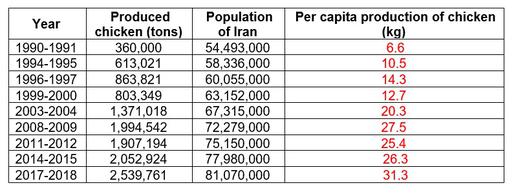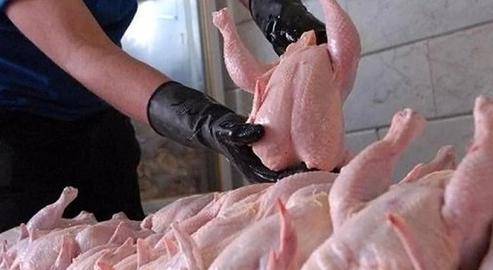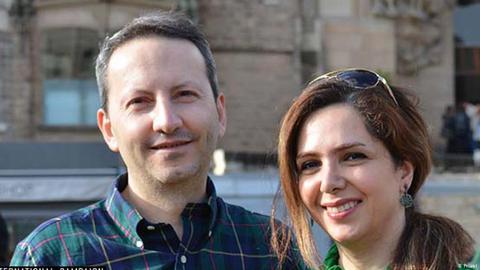"This is the way to neutralize and overcome sanctions. This path may lead to difficulties and problems in the beginning, but it has a happy ending."
These were the remarks delivered by the Supreme Leader of the Islamic Republic of Iran in one of his increasingly rare public appearances on Tuesday, November 24. At a meeting of the Supreme Economic Coordination Council, Khamenei again promoted his idea of an isolationist “resistance economy” – even as, due to the impact of sanctions and Covid-19, new manifestations of the financial crisis are surfacing in Iran every day.
The latest material evidence of this deterioration is the “chicken crisis”: a drastic surge in prices for this staple food item, even as consumption rates have soared. How did this come about, how can it be stopped, and what does it tell us about the “resistance economy” the Supreme Leader would like to propagate in Iran?
***
According to reports in Iranian media, the price of a kilogram of chicken in the markets of Tehran has now reached as high as 35,000 tomans (US$1.40). In other words, people living in the Iranian capital have to stump up between 50,000 and 70,000 tomans to buy a whole chicken to feed their families.
The Statistics Center of Iran reports that up until a month ago, the average price of a kilo of chicken in urban areas was under 20,000 tomans ($0.80). In other words, if both sets of reports are correct, the price of chicken has increased by more than 150 percent in a month – and further, it has tripled in the past year.
According to Iran Central Bank, chicken has replaced red meat in the Iranian diet over the past 20 years, with the volume of red meat consumption per household dropping from 90kh to 40kg while consumption of poultry has almost doubled. During the same period of time, the Statistics Center of Iran reports, per capita production of broiler chicken has increased sixfold.

These figures show that over the years, chicken has increasingly become a staple part of the Iranian diet. As such, these new, skyrocketing prices could pose a serious threat to the food security of Iranians who have spent the past 10 years in a continuous state of financial uncertainty.
What is Behind the Rise in Prices?
According to the director of the Broiler Farmers' Union, the unfair supply and distribution of livestock inputs – most importantly, water and chicken feed – and the rising costs of these commodities have put pressure on farmers, resulting in a reduced supply and higher prices.
At the same time, the Statistics Center’s latest inflation report shows production costs for the country's poultry farms have increased by 40 percent compared to the previous summer. In the previous year, poultry farmers also faced a 37 percent increase in production costs.
In addition, in recent months, there has been a proliferation of reports of an emerging crisis in the supply of foreign currency. This has thrown up barriers to the importation of basic goods the farmers need, including livestock inputs like chicken feed but also the hens themselves. Attempts to set up a full domestic, industrial chicken production chain have been fruitless in Iran, and the climate and severe water shortages mean Iran is also dependent on cornmeal from abroad. As such, just like businesses in other sectors, poultry farmers in Iran find themselves at the intersection of two painful realities: a reliance on imports, and difficulties thrown up by sanctions.
Since the return of US sanctions in 2018 the Iranian government has tried to protect the livestock input market from severe inflation by providing preferential foreign currency rates to farmers. The Iranian Central Bank allocated about 44 billion dollars, at a rate of 4200 tomans to the dollar, for farmers to import "basic goods". In the first seven months of 2020-2021 the allocated amount was eight billion dollars, of which around 2.5 billion was spent on barley and corn. But this, it transpires, has not been enough.
How to Solve the Chicken Crisis?
The crisis could be temporarily abated – and to some extent might even subside – through an injection of cash into the poultry market in the coming days or weeks. Even then, though, there is no guarantee that prices will not surge again. There is also every chance that similar crises could engulf other food staples such as bread.
Whether the Supreme Leader of the Islamic Republic likes it or not, Iran's food security depends on foreign relations. Iran needs both a steady supply of dollars and to re-establish its commercial ties with other countries in order to feed its people. “Neutralizing” sanctions, contrary to what Khamenei says, will have nothing to do with “resistance” but everything to do with having the courage and realism to recognize this dependance and act on it accordingly. Without this, more and more Iranian livelihoods – and indeed lives – will suffer the consequences.
visit the accountability section
In this section of Iran Wire, you can contact the officials and launch your campaign for various problems


























comments